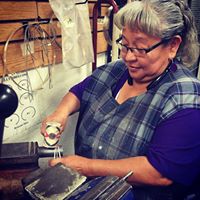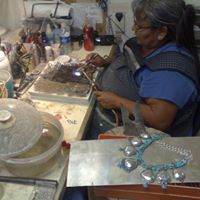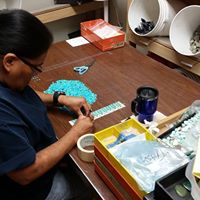Silversmithing and Silver
Dec 13th 2019



In addition to tools required for silversmithing, the silver itself is necessary.
The old-time Native American silversmith liked coin silver, often made from pesos. The old pesos that the Native Indian silversmiths melted for their jewelry probably were of a good grade of silver. The pesos issued for some years previous and until about 1940 were 0.720 fine and could be used for jewelry. These pesos were 1 5/16", in diameter.
Then in about 1947 two new coins were struck. a one-peso piece and a five peso piece. The one peso is 0.500 fine and 1 1/4" in diameter. The five peso is of a good quality of silver, marked 0.900. Coin silver in sheet from can be still obtained from some firms, but sterling silver is stocked wherever jewelers' supplies are sold.
Pure silver is too soft for ordinary jewelry work except for bezels. Bezels are the little rims soldered to jewelry to hold turquoise or other stones.
Sterling silver is an alloy of 925 parts pure silver and 75 parts copper, and is known as 925-1000 fine. Sterling silver comes in sheet and wire form. Sterling can be had in thickness of 14, 16, 18, 20, 22, 24, and 26 Brown & Sharp gauge, the smallest number being the thickest metal.
For ordinary work, it is well to buy some 16, 18, and 20 gauge silver perhaps 6 inches wide by whatever length is required. The 6 inch width is suggested because that is the usual length for a bracelet, and that is about the longest piece of silver that will be used for making in Indian jewelry. Twenty-gauge silver is just about 1/32 inches thick, while 16 gauge is about 3/64 inch thick. A piece of 26 gauge silver should be bought for making bezels. B & S 26 gauge silver is about 1/64 inches thick. Silver usually is sold by weight, but in ordering, it is customary to state the gauge and the dimensions desired.
Silver wire should also be on hand. This comes in thicknesses ranging from 14 to 30 B. & S. gauge. If a draw plate is among the equipment, the buying of wire is generally simplified as one gauge of wire is all that is necessary because the smaller sizes can be drawn as needed.
It is always easier to work with annealed silver. Silver wire usually comes annealed, but it is sometimes necessary to anneal sheet silver. Hammering silver rends to harden it, and drawing wire through a draw plate also hardens it. For this reason, wire is usually pulled through two holes and then coiled, heated, and immersed in cold water or a pickle solution before drawing it thinner or shaping it.






















